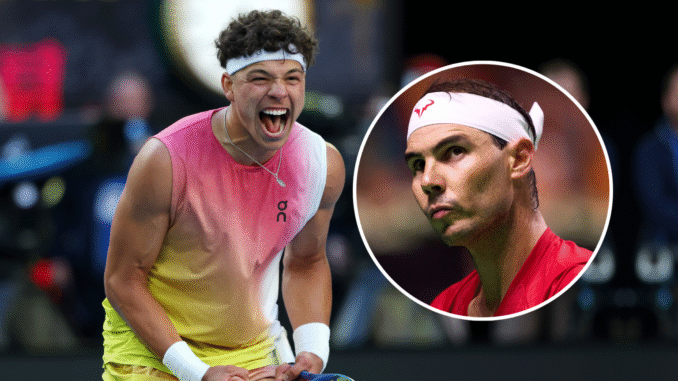
As the red clay of Roland Garros tests the mettle of tennis’s elite, Ben Shelton, the 22-year-old American sensation, is turning heads with a weapon reminiscent of the legendary Rafael Nadal: a devastating left-handed forehand. Fresh off a thrilling five-set victory over Italy’s Lorenzo Sonego in the first round of the 2025 French Open, Shelton is channeling the “King of Clay” as he aims to make his mark on a surface where he once struggled. His forehand, lauded for its heavy topspin and versatility, has drawn comparisons to Nadal’s iconic stroke, with analysts and fans alike buzzing about its potential to propel him deep into the tournament.
Shelton, ranked No. 14 and a fixture in the ATP top 15, burst onto the scene in 2022 after turning professional, foregoing his final year at the University of Florida, where he won the 2022 NCAA singles title. His rise has been meteoric, with two ATP titles, including a clay-court triumph at the 2024 U.S. Men’s Clay Court Championships in Houston, where he defeated Frances Tiafoe 7-5, 4-6, 6-3 to become the youngest champion since Andy Roddick in 2002. “I’m really looking forward to the clay,” Shelton said after his 2023 Australian Open quarterfinal run, expressing enthusiasm for a surface he once found challenging. “I’m looking forward to being able to use the higher bounces to my advantage, moving, sliding.” His 8-4 clay record in 2024, coupled with a final appearance at the German Open, signals his growing comfort on the red dirt.
The comparison to Nadal, a 14-time French Open champion, stems from Shelton’s left-handed forehand, a shot that mirrors the Spaniard’s lasso-like topspin. Mats Wilander, a seven-time Grand Slam champion, praised its potency: “I love the way he plays. His forehand – he can hit it hard, he can hit it flat or inside out but he can also hook it the way Rafael Nadal can do. That is the biggest weapon on clay, it’s the left-handed forehand which the topspin into the right-hander’s backhand. That would be the biggest weapon and Ben Shelton has that.” This ability to manipulate spin and angles, particularly against right-handers like Sonego, allows Shelton to dictate rallies and exploit defensive weaknesses, much like Nadal did during his 112-4 record at Roland Garros.
Shelton’s first-round clash with Sonego, a 6-4, 7-5, 4-6, 7-6 marathon on Court Philippe-Chatrier, showcased this weapon. Played hours after a tribute ceremony honoring Nadal’s retirement, the match carried symbolic weight. Shelton’s forehand, especially his inside-out variation, troubled Sonego, though the Italian’s superior clay-court movement forced Shelton to scramble. “He played some ridiculous tennis,” Shelton said of Sonego, acknowledging the challenge of facing a player adept at sliding into defensive positions. Despite 17 double faults and unforced errors, Shelton’s 56 aces and 79% first-serve points won underscored his aggressive style, with his forehand delivering crucial winners in the fourth-set tiebreak.
Unlike Nadal, whose clay dominance was built on relentless athleticism and a 2005-07 streak of 81 consecutive wins, Shelton’s game blends power with flair. His 149-mph serve, the fastest at the 2023 US Open, complements his forehand, but his clay-court learning curve remains steep. “With that bomb of a serve and his excellent movement, Shelton could be very interesting on clay,” said ESPN analyst Brad Gilbert, who coached Andre Agassi to the 1999 French Open title. Shelton’s 2-7 clay record before Houston in 2024 reflected his struggles, but his recent progress, including a Munich Open final, suggests he’s adapting to the surface’s demands for patience and tactical discipline.
As Shelton advances to face defending champion Carlos Alcaraz in the fourth round, the Nadal comparison takes on added significance. Alcaraz, who idolizes Nadal, has mastered clay with titles in Monte Carlo and Rome, but Shelton’s forehand could exploit the Spaniard’s backhand, especially if Alcaraz’s concentration wavers, as it did in his third-round scare against Damir Dzumhur. “Playing the defending champion, round of 16, I’m guessing center court, that’s a pretty cool opportunity,” Shelton enthused, relishing the challenge. With Nadal’s legacy looming large—his statue at Roland Garros immortalizing that lethal forehand—Shelton’s quest to emulate the Spaniard’s clay-court prowess is a compelling narrative, blending raw talent with the promise of American resurgence in Paris.
Leave a Reply